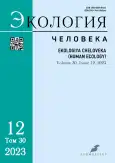Age-related anthropometric changes in physical development among aboriginal schoolchildren in Russia’s North-East
- Authors: Loskutova A.N.1
-
Affiliations:
- Scientific Research Center «Arktika» Far Eastern Branch of the Russian Academy of Sciences
- Issue: Vol 30, No 12 (2023)
- Pages: 879-890
- Section: ORIGINAL STUDY ARTICLES
- URL: https://journals.rcsi.science/1728-0869/article/view/262163
- DOI: https://doi.org/10.17816/humeco627050
- ID: 262163
Cite item
Full Text
Abstract
BACKGROUND: Schoolchildren from an educational institution of Severo-Evensk District Magadan Region, participated in an anthropometric survey.
AIM: To assess anthropometric characteristics of indigenous schoolchildren in the Magadan Region across different age-groups.
MATERIAL AND METHODS: Two hundred and eight boys and one hundred and ninety girls from the Evens, Koryaks and Itelmen ethnic groups participated in the 2021–2023 Anthropometric Survey. They accounted for 67.2% of all schoolchildren surveyed. Body height (BH), body mass (BM), chest circumference (CC), sitting height (HSit), right- and left-hand grip strength were measured. We also calculated annual increase in weight and height, as well as proportionality of physical development of the children.
RESULTS: A natural increase in the absolute body indicators of BH, BM, HSit, CC, and right and left hand strength have been observed parallel to increase in age from 8 to 17 years. The rate of annual growth indicated different timing of the periods of accelerated increase in the anthropometric characteristics. Girls exhibited a CC maximum increase at 10–11 years old with simultaneous increase in BH, BM, HSit, and hand grip strength at 11–12 years old. During the same age-periods, boys showed a pronounced BH growth with BM and CC increase at 12–13 years of age. After a slight attenuation in the growth rate, we observed a substantial increase in BH at the age of 14–15, associated with gender-related aspects in older children groups. Sex-related characteristics of BH increase were primarily associated with differences in the leg growth rates during the puberty, and tend to be greater in boys. Most of the studied boys had an asthenic somatotype. At the same time, most girls had a proportional body type with high percentage of those with relatively short legs.
CONCLUSION: We observed that girls were ahead of boys in their physical development. Boys demonstrated a continuous development in their main anthropometric characteristics with more pronounced dynamics in adolescence. Our findings suggest that indigenous schoolgirls have better physical development and adaptive adjustments compared to boys.
Full Text
##article.viewOnOriginalSite##About the authors
Alesya N. Loskutova
Scientific Research Center «Arktika» Far Eastern Branch of the Russian Academy of Sciences
Author for correspondence.
Email: lesa82@inbox.ru
ORCID iD: 0000-0001-5350-8893
SPIN-code: 2570-0124
Cand. Sci. (Biology)
Russian Federation, 24 avenue Karl Marx, Magadan, 685000References
- Kozlov A, Vershubsky G. Medical Anthropology of thе Native Inhabitants of the North of Russia. Moskow: MNEPU Publ; 1999. (In Russ.).
- Averyanova IV, Maksimov AL. Adaptation of functional systems in different generations of Caucasians in the North-East of Russia. Ekologiya cheloveka (Human Ecology). 2023;30(4):259–273. EDN: EPDVUK doi: 10.17816/humeco321856
- Astahova TA, Rychkova LV, Pogodina AV, et al. Status of health of adolescents of main ethnic groups of Eastern Siberia. Medical News of North Caucasus 2018;13(1–1):14–17. EDN: MCQNVA doi: 10.14300/mnnc.2018.13004
- Nadtochiy LA, Smirnova SV, Bronnikova EP. The depopulation of indigenous and small-numbered peoples and problem of preserving of ethnic groups of the north-east of hanty. Ekologiya cheloveka (Human Ecology). 2015;22(3):3–11. EDN: TMITDX doi: 10.17816/humeco17087
- Bezrukikh MM, Sonkin VD, Farber DA. Age physiology (Physiology of child development). Moscow: Akademiya; 2003. EDN: QKQNIL
- Sukhanova IV, Vdovenko SI, Maximov AL. Morphofunctional profiles observed in male subjects inhabiting different climato-geographic areas of Magadan region. Ekologiya cheloveka (Human Ecology). 2010;(3):24–30. EDN: KZVBBV
- Khakhovskaya LN. The modern social-economical status of indigenous population in the North Even area of Magadan region. The Bulletin of the North-East Scientific Center. 2007;(4):98–104. EDN: KUHHSR
- Results of the 2020 All-Russian Population Census. Available from: https://27.rosstat.gov.ru/folder/64093 Accessed: Dec 25, 2023. (In Russ.)
- Bunak VV. Anthropometry. Moscow: Uchpedgiz; 1941. (In Russ.).
- Nikitjuk DB, Popov VI, Skoblina NA., et al. Standards for assessing the physical development of children and adolescents in the Russian Federation. Part 2. Moscow: Nauchnaya kniga; 2023. (In Russ.) EDN: SWBDWI
- Baitrak OA, Mescheryakov VV, Girsh YaV. Characteristics of sexual development of ethnic hanty and alien population in the Middle Ob region. Doctor.Ru. 2021;20(3):45–49. EDN: ZENXHM doi: 10.31550/1727-2378-2021-20-3-45-49
- Nifontova OL. Konkova KS. Physical development of high school students living on the territory of Khanty-Mansi autonomous okrug — Ugra. Ekologiya cheloveka (Human Ecology). 2018;(10):24–31. EDN: YLBXOH doi: 10.33396/1728-0869-2018-10-24-31
- Sokolov AYa, Grechkina LI. Sex-related and ethnic differences of physical development of adolescents in Russian North-East. Ekologiya cheloveka (Human Ecology). 2008;(8):22–25. EDN: JUUNGB
- Karandasheva VO. Child and adolescent anthropometric dynamics in ontogeny of 10-17 age in regional aspect of Magadan. Lomonosov Journal of Anthropology (Moscow University Anthropology Bulletin). 2023;(3):41–51. EDN: QKIRZP doi: 10.32521/2074-8132.2023.3.041-051
- Averyanova IV. Age-related anthropometric characteristics of young aboriginal residents in the Northeast of Russia. Ekologiya cheloveka (Human Ecology). 2020;27(7):21–26. EDN: GRMIDZ doi: 10.33396/1728-0869-2020-7-21-26
- Alexeeva TI. Geographic Environment and Human Biology. Moscow: Mysl’; 1977. (In Russ.)
- Yur’ev VV, Simakhodskiy AS, Voronovich NN, Khomich MM. Growth and Developments of a Child. Saint Petersburg: Piter; 2007. (In Russ.) EDN: VSLEZZ
- World Health Organisation (WHO). Adolescent Health. Available at: https://www.who.int/ru/health-topics/obesity#tab=tab_1 Accessed: Dec 25, 2023.
- Aleksandrov AA, Kisliak OA, Leontyeva IV. Clinical guidelines on arterial hypertension diagnosis, treatment and prevention in children and adolescents. Systemic Hypertension. 2020;17(2):7–35. EDN: MIRZHC doi: 10.26442/2075082X.2020.2.200126
- Milushkina OYu, Skoblina NA, Prusov PK, et al. The influence of physical development indicators on the formation of muscle strength in adolescent boys. Pacific Medical Journal. 2018;(2):66-69. EDN: XPUYHJ doi: 10.17238/PmJ1609-1175.2018.2.66-69
- Baitrak OA, Meshcheryakov VV, Somova TM. Comparative analysis of indicators of blood pressure in children and adolescents of foreign and indigenous population in the Middle Priobye. Vestnik Surgu. Medicina. 2020;(2):33–44. EDN: TXJTMZ doi: 10.34822/2304-9448-2020-2-33-40
Supplementary files









